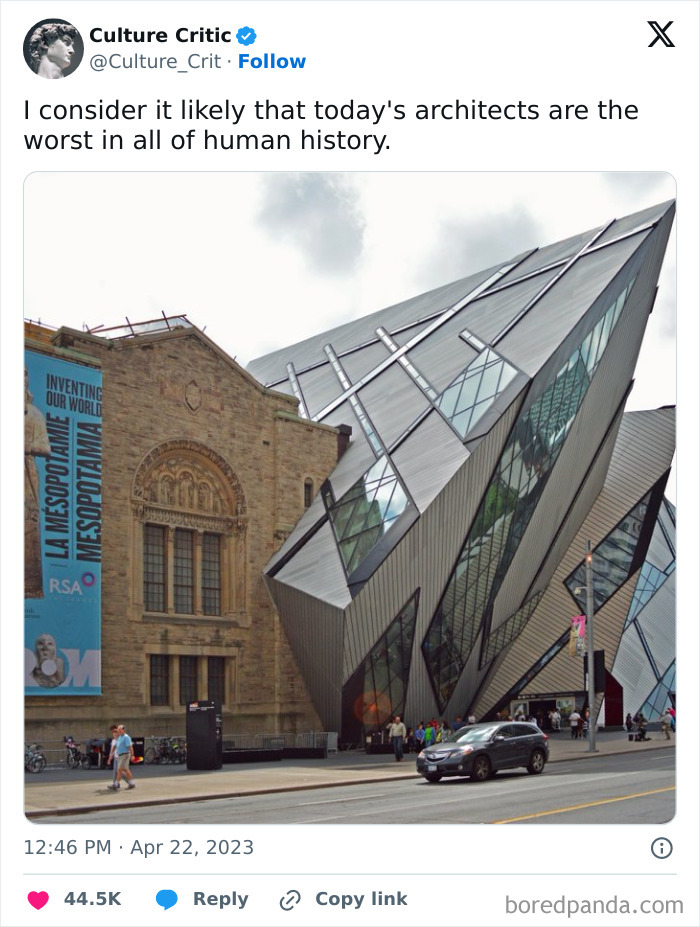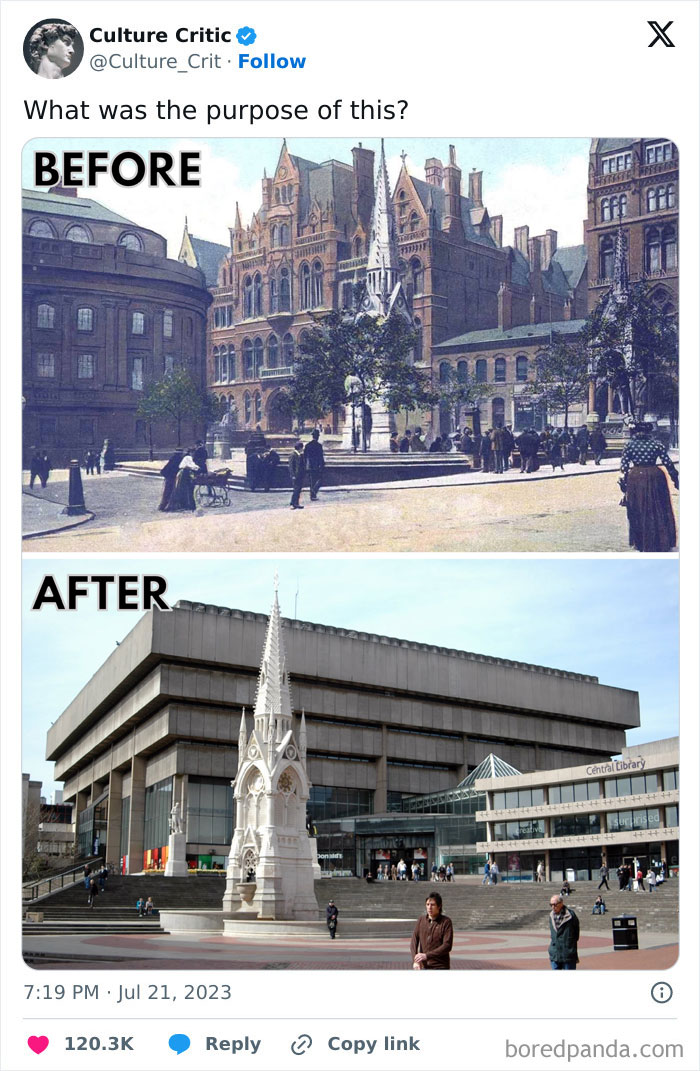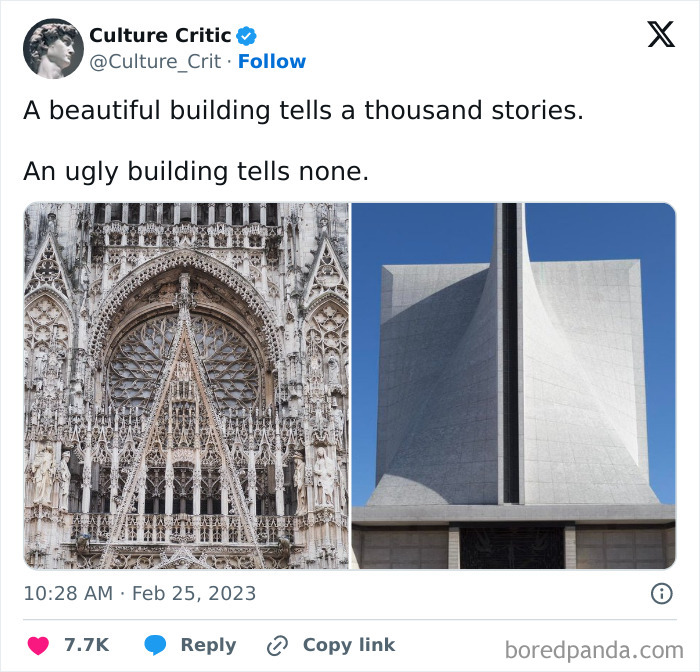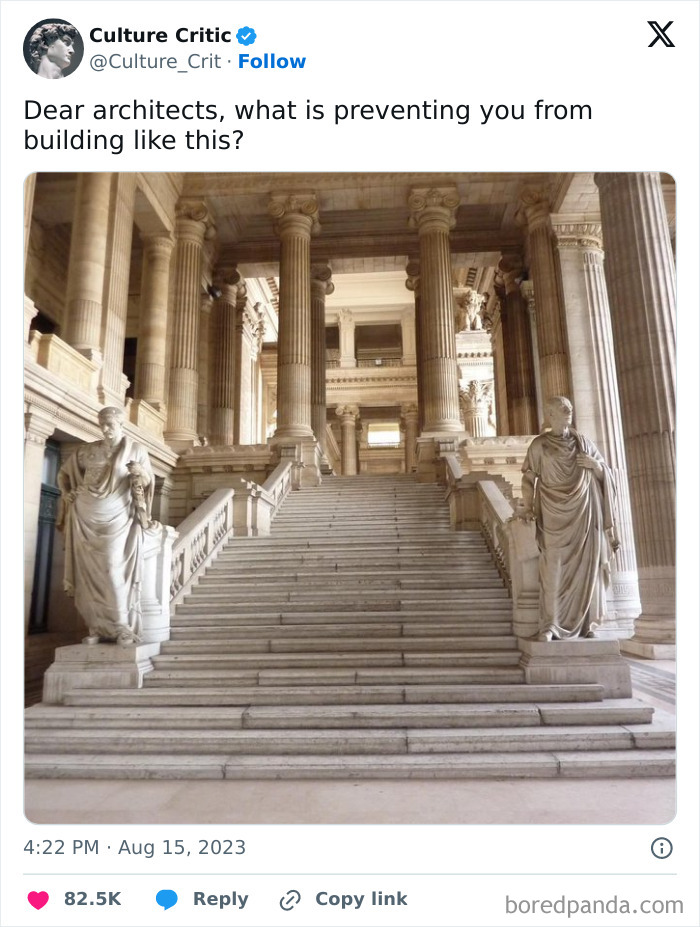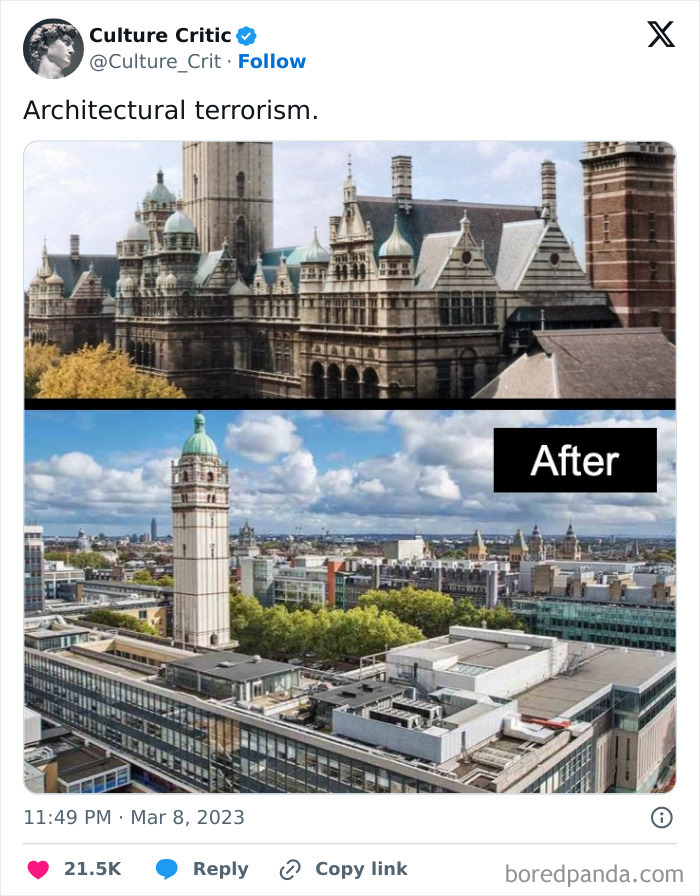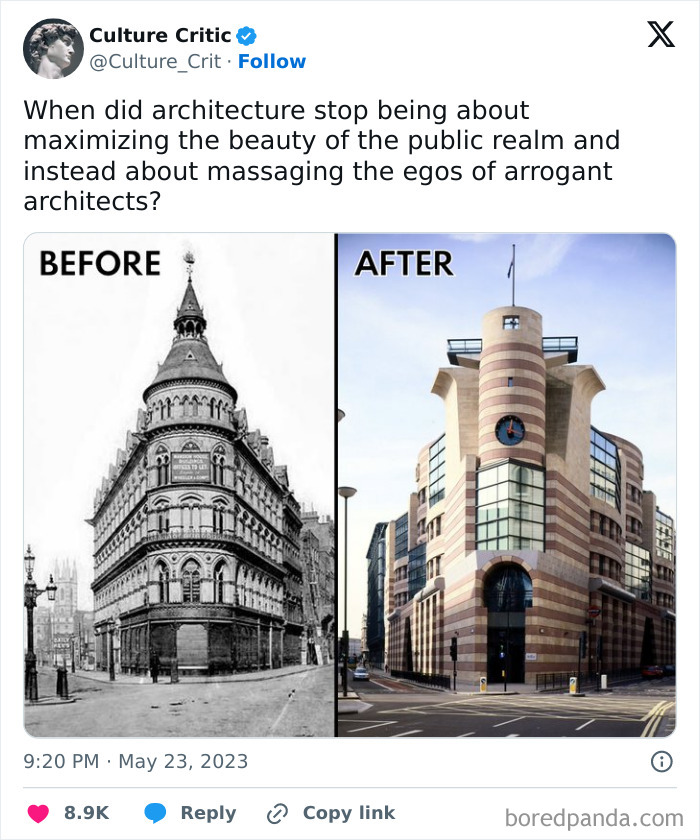
35 Unfortunate Pics From “Culture Critic” Showing How Architecture Is Becoming Increasingly Sad
There are some buildings on the planet that will simply take your breath away: the Taj Mahal, La Sagrada Familia in Barcelona, the Colosseum, the Blue Mosque in Istanbul, and the Sistine Chapel, among others of course. These are true testaments to the incredible structures that humans can create when they have the vision, energy and resources.
Nowadays, however, it’s rare to find a new building that makes visitors say anything other than, “It’s alright.” And one Twitter account that’s dedicated to calling out lackluster modern architecture is Culture Critic. Below, we’ve gathered a list of pics from this page that might make our ancestors shudder, so enjoy scrolling through, and be sure to upvote the ones that make you wish you had lived several hundred years ago!
This post may include affiliate links.
Awful eyesore. This is a terrible planning decision to allow it to be built.
Does anyone know why there's a giant butt-plug in the second picture?
The Culture Critic Twitter account has only been around since 2020, but it’s already made quite a name for itself on the site, amassing an impressive 718.4k followers. The page has a simple description, stating, “Tradition is not the worship of ashes, but the preservation of fire.” And over the past few years, it has shared nearly 1,400 tweets celebrating amazing art and architecture of the past, while also calling out some of the most disappointing pieces and structures of our modern day.
Of course, everyone is allowed to have their own preferences when it comes to which buildings they consider the most impressive or most amazing in the world. But if you take a look at almost any list featuring the planet’s most breathtaking structures, you’ll quickly find that many of them were built at least a century ago. Plenty were even built several hundred years ago! So why don’t we create buildings like we used to anymore? Clearly, we still find them beautiful, so what happened to ornate churches and stunning state buildings? First, let’s take a look at Gothic architecture in particular.
This is my ADHD brain getting distracted half way through.
According to Newspire, you don’t see Gothic buildings popping up in your city today due to several reasons: these structures are incredibly expensive to build and maintain, the style isn’t really in fashion anymore, and there aren’t enough skilled stoneworkers to create the intricate designs today. Building planners would be required to pay a pretty penny for these kinds of structures, and they don’t always have the resources or time needed. Also, no matter how much you may love the Notre-Dame, this style of building has been deemed outdated.
The peak of Gothic architecture was around the 12th and 13th centuries, and since then, the Renaissance and Baroque styles pushed these designs out of the forefront of architects' minds, and they have rarely been revisited since. And nowadays, it would be extremely challenging to find builders who are familiar with and skilled enough in the construction techniques needed to perfect a gorgeous Gothic building.
But of course, Gothic structures are not the only gorgeous buildings that we don’t see anymore. So why are modern structures so ugly? Well, according to Nader Sammouri at ADF Magazine, a lot of it comes down to today’s architecture being a business. There’s not as much of an emphasis on aesthetics or creating a beautiful structure that will complement a city. Architects are often given small budgets and strict time constraints, so they make do to earn a paycheck. Plus, there are many other factors at play today, including government regulations, safety codes and political agendas that may impact how much freedom an architect actually has.
They quite possibly do, but not necessarily in the same way.
Despite being eyesores, many modern buildings are actually terrible for our planet as well. John Barham wrote a piece for Medium explaining how the materials used nowadays make buildings last for much less time than their predecessors. “Switching from wood, bricks, and stone, to concrete, composites, and plastics is a big part of the issue, as these new ‘low maintenance’ components often really mean ‘un-maintainable’ and so become destined for landfills,” Barham writes. “For example, while a wooden sash window will need regular repainting it can last hundreds of years, but a plastic window once damaged will need to be completely thrown away.”
Barham also notes that the ideology behind modern architecture is a problem as well. He notes that architects today argue that because beauty is subjective, they don’t need to worry about intricate details or trying too hard to make a structure stunning. “When they find themselves bored by the dullness of a sheer glass and concrete façade of a pastiche Minimalism, they turn to irregular, incoherent, asymmetric shapes, or uncomfortable cantilevers,” Barham writes. “They claim their brief is to shock with ‘originality’ or to ‘challenge’ the public. The results are anti-human buildings that do not ‘spark joy’.”
Creating buildings while solely being concerned with function also does a disservice to future residents or occupants, as they will no doubt want to renovate or rebuild. If the structure isn’t timelessly beautiful, there’s no reason to preserve it. And the cycle of tearing down and using resources to rebuild continues. So the solution to this, Barham suggests, is to actually build structures intended to last forever. He notes how many pre-modern buildings have been homes, offices, retail spaces and gone back and forth between all of the above simply because the spaces were so beautiful and timeless that there was no desire to alter them.
“FLAT. IT NEEDS TO BE FLAT. sorry for my outburst, but it needs to be so that if giants invade, they can sit down comfortably, without something spiking up their a*se.”
According to ScienceNordic, beauty in architecture can even be used as a strategy for sustainability. Nicolai Bo Andersen, associate professor at the Institute for Architecture and Culture at the Royal Danish Academy for Fine Arts, School of Architecture, says that it’s important to focus on aesthetics and ensuring that buildings can physically stand the test of time. “It’s a question of how we experience architecture,” Andersen says. “A building’s form, color, proportions, materials, and daylight, directly affect the human body and give a feeling of connectedness to the world. Beauty may be understood as the uplifting feeling experienced through the body and the senses.”
NOOOOOOOOOOOOOOOOOOOOOOOOOOOOOOOOOOOOOOOOOOOOOOOOOOOOOOOOOOOOOOOOOOOOOOOOOOOOOOOOOOOOOOOOOOOOOOOOOOOOOOOOOOOOOOOOOOOOOOOOOOOOOOOOOOOOOOOOOOOOOOOOOOOOOOOOOOOOOOOOOOOOOOOOOOOOOOOOOOOOOOOOOOOOOOOOOOOOOOOOOOOOOOOOOOOOOOOOOOOOOOOOOOOOOOOOOOOOOOOOOOOOOOOOOOOOOOOOOOOOOOOOOOOOOOOOOOOOOOOOOOOOOOOOOOOOOOOOOOOOOOOOOOOOOOOOOOOOOOOOOOOOOOOOOOOOOOOOOOOOOOOOOOOOOOOOOOOOOOOOOOOOOOOOOOOOOOOOOOOOOOOOOOOOOOOOOOOOOOOOOOOOOOOOOOOOOOOOOOOOOOOOOOOOOOOOOOOOOOOOOOOOOOOOOOOOOOOOOOOOOOOOOOOOOOOOOOOOOOOOOOOOOOOOOOOOOOOOOOOOOOOOOOOOOOOOOOOOOOOOOOOOOOOOOOOOOOOOOOOOOOOOOOOOOOOOOOOOOOOOOOOOOOOOOOOOOOOOOOOOOOOOOOOOOOOOOOOOOOOOOOOOOOOOOOOOOOOOOOOOOOOOOOOOOOOOOOOOOOOOOOOOOOOOOOOOOOOOOOOOOOOOOOOOOOOOOOOOOOOOOOOOOOOOOOOOOOOOOOOOOOOOOOOOOOOOOOOOOOOOOOOOOOOOOOOOOOOOOOOOOOOOOOOOOOOOOOOOOOOOOOOOOOOOOOOOOOOOOOOOOOOOOOOOOOOOOOOOOOO
We’re not saying it’s impossible to create a beautiful building today, but obviously, structures like the Sistine Chapel don’t pop up every day. It’s important to keep enjoying and preserving these amazing buildings, and perhaps one day we will have another creation on par with the Taj Mahal. And if not, at least we can continue admiring the one and only. And roasting all of the ugly, lackluster modern buildings on Twitter!
Are these pictures making you ashamed to be living in modern times, pandas? Unless you’re an architect with an unlimited budget, don’t beat yourself up. It’s not your fault! But we hope you’re enjoying these reminders of how amazing old buildings are and that we should do everything we can to preserve them. Keep upvoting the pics that hit home for you, and then if you’re interested in checking out another Bored Panda article featuring questionable modern architecture, look no further than right here!
Why? Rich people don't buy are to look at. They buy it because it's got a high value that will likely keep going up. It's a way to store their money.
The sponsored this restoration so... also they did it for its historical and artistic value, nor because of its religious purposes since many Europeans, including the French, are blatant atheists or agnostics.
It's the city hall of Stuttgart, wich was severly damaged during a WW2 bombing raid.
This is one where I disagree. The new structure is not experimental brutalism, but a very practical attempt to make a pleasant indoor environment. Behind and to the left, you see an even more modern building which attempts to be beautiful while allowing for an all-glass exterior. I do find beauty in many modern architectural works; while Lloyd's is horrifying and Tate looks like it Pink Floyd's Wish You Were Here was exalting what it damned, the Shard and the Gherkin have their own beauty.
While I really love old architecture, the reason why we don't build these super intricate buildings anymore is partially for good reasons. In pre-victorian times, labour wages were so low compared to material costs that ornate detailing was not that much more of an expense. Nowadays, labour costs are the majority of building costs (not saying that we pay all workers fairly, but at least more than they used to) which makes it really expensive to replicate those styles. And let also not forget that the buildings that stayed, were not representative for what most people lived in😉
Also, so many of the old buildings were completely inaccessible for disabled people, almost impossible to retrofit with modern wiring, plumbing and computer access, offered little in the way of security, etc. The costs of refurbishing the buildings and keeping them to a modern standard are often many times the cost of starting over.
Load More Replies...This culture critic feels one step adjacent to old man shouts at clouds kids today grumble grumble grumble things were better in the past etc. vibe
This is more about the state of corporate utilitarianism. That fish one is a good example. Architect comes up with an "interesting" design. But the client wants as much floor space as possible so all the cool lines are taken out and it becomes a bloated bubble. A huge glass cube gives you the maximum sqm per £ spent. Look at all the carving on the cathedrals, modern clients would not tolerate that amount of decoration/expense without utility.
Except it is not always the case. Architects may come up with an "'interesting' design," but it is the engineers that have get it built. And architects don't always design buildings with structural engineering in mind. Sometimes the design has to be changed so the building can be built and remain standing for more that 10 years.
While I really love old architecture, the reason why we don't build these super intricate buildings anymore is partially for good reasons. In pre-victorian times, labour wages were so low compared to material costs that ornate detailing was not that much more of an expense. Nowadays, labour costs are the majority of building costs (not saying that we pay all workers fairly, but at least more than they used to) which makes it really expensive to replicate those styles. And let also not forget that the buildings that stayed, were not representative for what most people lived in😉
Also, so many of the old buildings were completely inaccessible for disabled people, almost impossible to retrofit with modern wiring, plumbing and computer access, offered little in the way of security, etc. The costs of refurbishing the buildings and keeping them to a modern standard are often many times the cost of starting over.
Load More Replies...This culture critic feels one step adjacent to old man shouts at clouds kids today grumble grumble grumble things were better in the past etc. vibe
This is more about the state of corporate utilitarianism. That fish one is a good example. Architect comes up with an "interesting" design. But the client wants as much floor space as possible so all the cool lines are taken out and it becomes a bloated bubble. A huge glass cube gives you the maximum sqm per £ spent. Look at all the carving on the cathedrals, modern clients would not tolerate that amount of decoration/expense without utility.
Except it is not always the case. Architects may come up with an "'interesting' design," but it is the engineers that have get it built. And architects don't always design buildings with structural engineering in mind. Sometimes the design has to be changed so the building can be built and remain standing for more that 10 years.

 Dark Mode
Dark Mode 

 No fees, cancel anytime
No fees, cancel anytime 
















